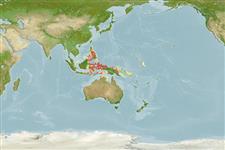Classification / Names
Common names | Synonyms | Catalog of Fishes (gen., sp.) | ITIS | CoL | WoRMS | Cloffa
Actinopterygii (ray-finned fishes) >
Perciformes (Perch-likes) >
Gobiidae (Gobies) > Gobiinae
Etymology: epistigmata: Name from Greek combination of 'epi' meaning over, and 'stigmata', meaning spot or mark, referring to the dark mark on the upper portion of the caudal peduncle.
Environment / Climate / Range
Ecology
Marine; pelagic-neritic; depth range 1 - 5 m (Ref. 96083). Tropical, preferred ?
Western Pacific: Indonesia and Papua New Guinea.
Size / Weight / Age
Maturity: Lm ? range ? - ? cm
Max length : 1.6 cm SL male/unsexed; (Ref. 96083)
Short description
Morphology | Morphometrics
Dorsal
spines
(total): 7;
Dorsal
soft rays
(total): 8;
Anal
spines: 1;
Anal
soft rays: 7 - 8;
Vertebrae: 26. This species is distinguished by the following characters: fifth pelvic-fin ray absent or rudimentary; 5 or fewer dark internal spots or bands between anal-fin origin and caudal fin; no distinct markings on pectoral-fin base; similar with E. nigramembrana, it has a small, dark occipital spot; differs from E. nigramembrana by not having an obvious area of dark pigment on the opercular membrane; edges of the scale pockets are more heavily pigmented than E. nigramembrana; has a dark internal mark above the midline of the ural centrum (vs. on the middle of the centrum in E. nigripinna and over the entire centrum in E. winterbottomi); dorsal fin dark dusky basally and marginally, pale or light dusky in central portion of fin (Ref. 96083).
Life cycle and mating behavior
Maturity | Reproduction | Spawning | Eggs | Fecundity | Larvae
Greenfield, D.W. and S.L. Jewett, 2014. Two new dwarfgobies from the Western Pacific (Teleostei: Gobiidae: Eviota). Copeia 2014(1):56-62. (Ref. 96083)
IUCN Red List Status (Ref. 115185)
CITES (Ref. 94142)
Not Evaluated
Threat to humans
Harmless
Human uses
More information
Common namesSynonymsMetabolismPredatorsEcotoxicologyReproductionMaturitySpawningFecundityEggsEgg development
Age/SizeGrowthLength-weightLength-lengthLength-frequenciesMorphometricsMorphologyLarvaeLarval dynamicsRecruitmentAbundance
ReferencesAquacultureAquaculture profileStrainsGeneticsAllele frequenciesHeritabilityDiseasesProcessingMass conversion
Tools
Special reports
Download XML
Internet sources
